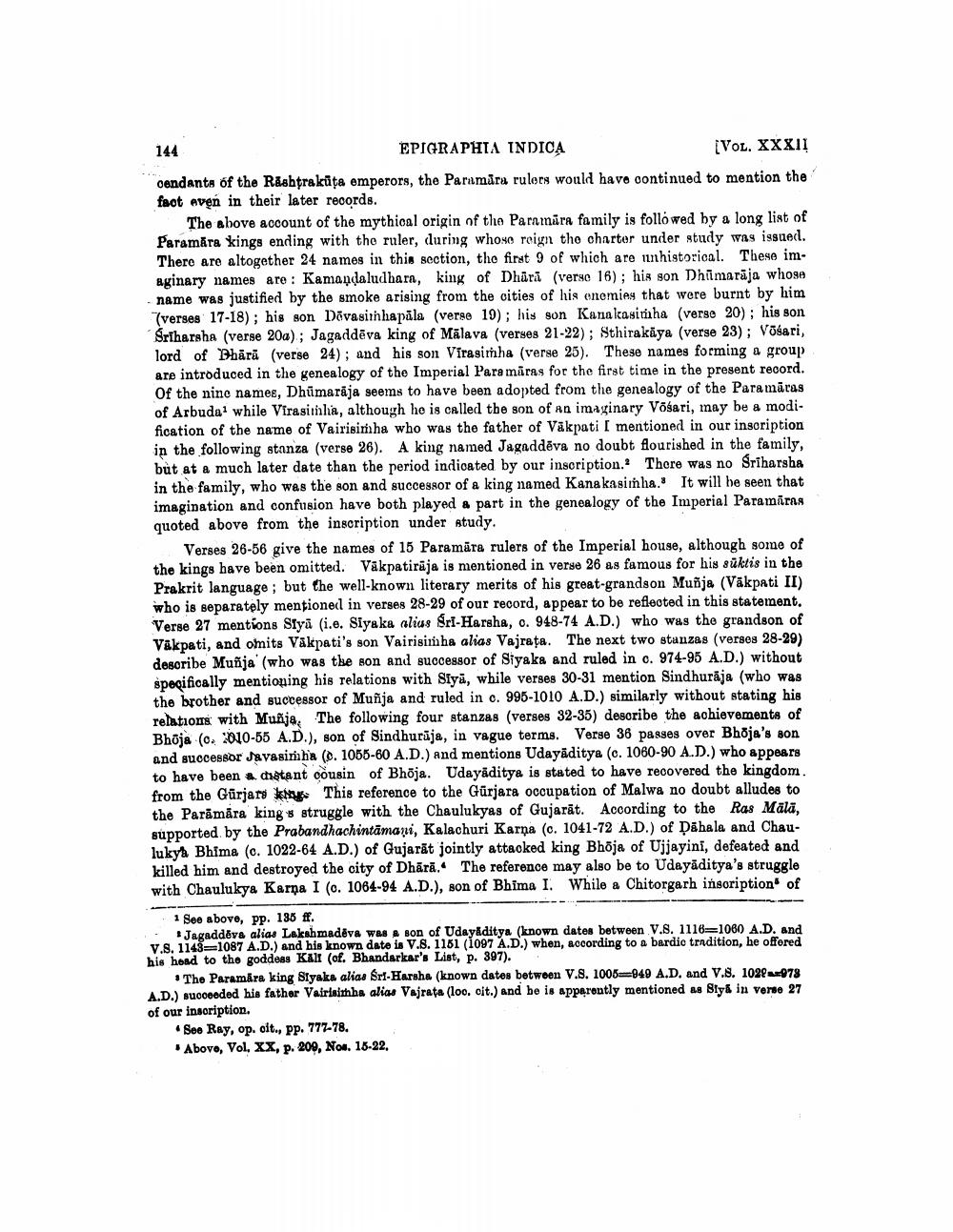________________
EPIGRAPHIA INDICA
VOL. XXXII cendants of the Răshtrakūta emperors, the Paramāra rulers would have continued to mention the fact even in their later records.
The above account of the mythical origin of the Parnmāra family is followed by a long list of Paramāra kings ending with the ruler, during whose reign the charter under study was issued. There are altogether 24 names in this section, the first 9 of which are inhistorical. These imaginary names are: Kamandaludhara, king of Dhūrā (verse 16); his son Dhimarāja whoge name was justified by the smoke arising from the cities of his enemiey that were burnt by him "verses 17-18); his son Divasirnhapāla (verse 19); his son Kanalasitha (verse 20); his son Sriharsha (verse 20a); Jagaddēva king of Mālava (verses 21-22); Sthirakiya (verse 23); Võsari, lord of Dhärä (verse 24); and his son Virasimha (verse 25). These names forming a group are introduced in the genealogy of the Imperial Para māras for the first time in the present record. Of the nine names, Dhūmarāja seems to have been adopted from the genealogy of the Paramāras of Arbuda? while Virasiilia, although he is called the son of an imaginary Võsari, may be a modification of the name of Vairisimha who was the father of Vakpati I mentioned in our inscription in the following stanza (verse 26). A king named Jagaddēva no doubt flourished in the family, but at a much later date than the period indicated by our inscription. There was no Sriharsha in the family, who was the son and successor of a king named Kanakasimha. It will be seen that imagination and confusion have both played a part in the genealogy of the Imperial Paramiras quoted above from the inscription under Atudy.
Verses 26-56 give the names of 15 Paramāra rulers of the Imperial house, although some of the kings have been omitted. Vakpatirāja is mentioned in verse 26 as famous for his sūktis in the Prakrit language; but the well-known literary merits of his great-grandson Muñja (Vākpati II) who is separately mentioned in verses 28-29 of our record, appear to be reflected in this statement. Verse 27 mentions Siyū (i.e. Siyaka alias Sri-Harsha, 0.948-74 A.D.) who was the grandson of Vakpati, and omits Väkpati's son Vairisinha alias Vajrata. The next two stanzas (verses 28-29) describe Muñja (who was the son and successor of Siyaka and ruled in o. 974-95 A.D.) without specifically mentioning his relations with Siya, while verses 30-31 mention Sindhurāja (who was the brother and successor of Muñja and ruled in c. 996-1010 A.D.) similarly without stating his relations with Muñja. The following four stanzas (verses 32-35) describe the achievements of Bhöja (c. 2010-55 A.D.), son of Sindhurūja, in vague terms. Verse 36 passes over Bhoja's son and successor Jayasinha (o. 1056-60 A.D.) and mentions Udayāditya (c. 1060-90 A.D.) who appears to have been distant cousin of Bhoja. Udayāditya is stated to have recovered the kingdom. from the Gurjars k . This reference to the Gürjara occupation of Malwa no doubt alludes to the Parāmāra kings struggle with the Chaulukyag of Gujarāt. According to the Ras Mali, supported by the Prabandhachintamani, Kalachuri Karna (c. 1041-72 A.D.) of Pahala and Chaulukyk Bhima (c. 1022-64 A.D.) of Gujarāt jointly attacked king Bhoja of Ujjayini, defeated and killed him and destroyed the city of Dhārā. The reference may also be to Udayāditya's struggle with Chaulukya Karna I (c. 1064-94 A.D.), son of Bhima I. While a Chitorgarh insoription of
1 See above, pp. 135 ff. - Jagaddēva alias Lakshmadēva was a son of Udayaditya (known dates between V.8. 1116=1080 A.D. and V.S. 1143-1087 A.D.) and his known date is V.8. 1151 (1097 A.D.) when, according to a bardie tradition, he offered his head to the goddess Kali (of. Bhandarkar's List, p. 397).
The Paramira king Siyaka alia, Sri-Harsha (known dates between V.8. 2008-049 A.D. and V.8. 102:978 A.D.) succeeded his father Vairiaitha alias Vajrata (loo. cit.) and he is apparently mentioned as Blya in verse 27 of our inscription.
See Ray, op. cit., pp. 777-78. Abovo, Vol. XX, p. 209, Nos. 15-22.




